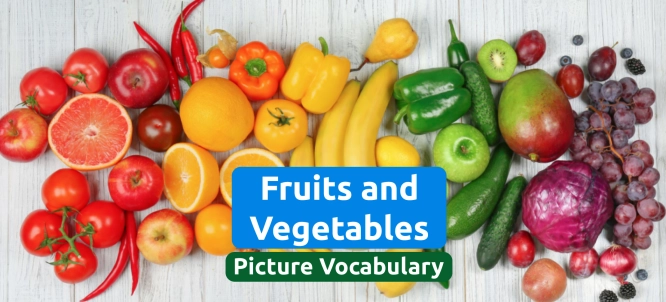by PushtoLearn
Fruits and Vegetables
Table of Contents
Fruits and Vegetables - A1 Exercises
These exercises focus on Fruits and Vegetables vocabulary
1. Fruits
Fruits are usually sweet and juicy. They grow on trees, bushes, and vines. Fruits are often eaten fresh and are perfect for snacks.
|
Fruit |
Description |
Health Benefits |
|
Apple |
Round, red or green, crunchy, and juicy. |
High in fiber and vitamins. |
|
Banana |
Long, yellow, and soft when peeled. |
Great source of potassium and energy. |
|
Orange |
Round, orange, with a juicy and tangy taste. |
High in vitamin C, good for the immune system. |
|
Strawberry |
Red with tiny seeds on the outside, sweet. |
Rich in antioxidants and vitamin C. |
|
Grapes |
Small, round, green or purple, often in bunches. |
Good for heart health and full of antioxidants. |
|
Watermelon |
Large, green on the outside, red and juicy inside. |
Hydrating and high in vitamins A and C. |
|
Pineapple |
Spiky on the outside, yellow and sweet inside. |
Boosts immunity and aids digestion. |
|
Mango |
Oval, yellow or orange flesh, very sweet. |
High in vitamins A and C, good for skin health. |
|
Blueberry |
Small, round, dark blue, and sweet. |
High in fiber and antioxidants. |
|
Peach |
Soft, fuzzy skin, juicy and sweet inside. |
Good for skin and eye health. |

2. Vegetables
Vegetables are often less sweet than fruits and can be eaten raw or cooked. They provide essential vitamins, minerals, and fiber.
|
Vegetable |
Description |
Health Benefits |
|
Carrot |
Long, orange, crunchy, and slightly sweet. |
Great for eyesight and high in vitamin A. |
|
Broccoli |
Green, looks like small trees, crunchy. |
High in fiber and vitamins C and K. |
|
Spinach |
Dark green leaves, soft and mild taste. |
Good for iron and bone health. |
|
Tomato |
Red and round, juicy inside. |
High in vitamin C and good for heart health. |
|
Potato |
Brown skin, white or yellow inside, starchy. |
Good source of energy and potassium. |
|
Cucumber |
Green, long, and crunchy, full of water. |
Hydrating and good for skin health. |
|
Pepper (Bell) |
Comes in green, red, yellow, and orange, crunchy. |
High in vitamins A and C, good for vision. |
|
Onion |
Brown or white, strong smell, layers inside. |
Good for heart health and has antibacterial properties. |
|
Lettuce |
Light green leaves, crunchy, mild flavor. |
Low in calories, good for hydration and digestion. |
|
Eggplant |
Purple, shiny, and soft when cooked. |
High in fiber and antioxidants. |
3. Root Vegetables
Root vegetables grow underground and are often starchy. They are filling and provide good energy.
|
Root Vegetable |
Description |
Health Benefits |
|
Carrot |
Orange, crunchy, and sweet. |
Good for eyesight (high in vitamin A). |
|
Potato |
Brown outside, starchy white inside. |
Source of energy, potassium, and vitamin C. |
|
Sweet Potato |
Brown or purple skin, orange inside, sweet. |
High in fiber and vitamin A, good for digestion. |
|
Beetroot |
Dark red, round, and sweet when cooked. |
Good for heart health and rich in antioxidants. |
|
Radish |
Small, red or white, crunchy, and spicy. |
Good for digestion and low in calories. |
4. Leafy Greens
Leafy greens are packed with nutrients and can be eaten raw in salads or cooked. They’re very healthy and low in calories.
|
Leafy Green |
Description |
Health Benefits |
|
Spinach |
Dark green, soft leaves, mild taste. |
Good for iron, bone health, and energy. |
|
Lettuce |
Light green, crunchy, often used in salads. |
Hydrating and good for digestion. |
|
Kale |
Dark green, curly leaves, slightly bitter. |
Very high in vitamins and antioxidants. |
|
Cabbage |
Green or purple, layered leaves, crunchy. |
Good for digestion and immune support. |
|
Collard Greens |
Large, dark green leaves, often cooked. |
High in vitamins K and A, good for bones. |
5. Berries
Berries are small, juicy, and sweet or tangy. They’re great for snacks, desserts, or adding to cereal.
|
Berry |
Description |
Health Benefits |
|
Strawberry |
Red with seeds on the outside, sweet and juicy. |
High in vitamin C and good for skin health. |
|
Blueberry |
Small, round, and blue, with a sweet flavor. |
Rich in antioxidants and good for brain health. |
|
Raspberry |
Red, tiny clusters, sweet and slightly tart. |
High in fiber and vitamins. |
|
Blackberry |
Dark purple, sweet and juicy. |
Full of vitamins C and K, good for immunity. |
|
Cranberry |
Red, very tart, often eaten dried or in juice. |
Good for urinary health and immunity. |
Quick Reference Table for Fruits and Vegetables
|
Type |
Examples |
|
Fruits |
Apple, Banana, Orange, Mango, Strawberry |
|
Vegetables |
Carrot, Broccoli, Spinach, Potato, Tomato |
|
Root Vegetables |
Carrot, Potato, Sweet Potato, Beetroot |
|
Leafy Greens |
Spinach, Lettuce, Kale, Cabbage, Collard Greens |
|
Berries |
Strawberry, Blueberry, Raspberry, Blackberry |
Fun Facts About Fruits and Vegetables
-
Bananas are actually berries, but strawberries aren’t!
-
Tomatoes are fruits because they have seeds, but they’re often used as vegetables.
-
Watermelons are 92% water, making them great for hydration.
-
Carrots were originally purple; the orange color became popular later.
-
Broccoli is part of the cabbage family, along with cauliflower and Brussels sprouts.
Example Sentences Using Fruit and Vegetable Vocabulary
-
"I eat an apple every day for a healthy snack."
-
"We use spinach in salads and in cooking because it’s full of iron."
-
"Carrots and beetroots grow underground as root vegetables."
-
"Strawberries are my favorite berries because they are sweet and juicy."
-
"My mom adds broccoli to our pasta for extra vitamins."
FAQ
Are tomatoes fruits or vegetables?
Botanically, tomatoes are fruits because they contain seeds, but they’re often treated as vegetables in cooking.
Why are leafy greens so healthy?
Leafy greens are packed with vitamins, fiber, and minerals but are low in calories, making them great for energy and health.
What is the difference between fruits and vegetables?
Fruits have seeds and usually taste sweet or tangy, while vegetables are more savory and come from various parts of plants (like leaves, roots, or stems).
Which fruits and vegetables are high in vitamin C?
Oranges, strawberries, bell peppers, and broccoli are all rich in vitamin C, which helps the immune system.
Can fruits and vegetables be frozen?
Yes, many fruits and vegetables can be frozen to stay fresh longer. Frozen berries, spinach, and broccoli are easy to use in cooking.

